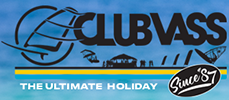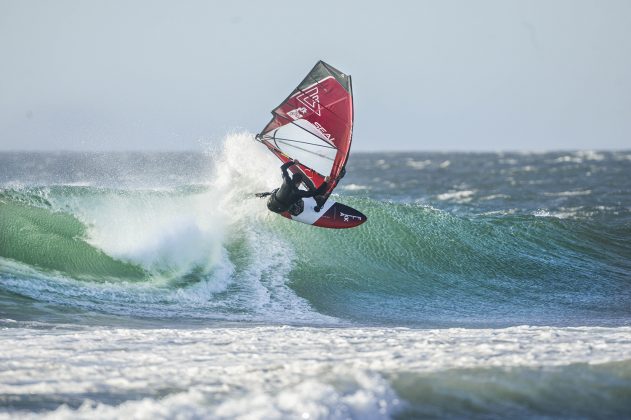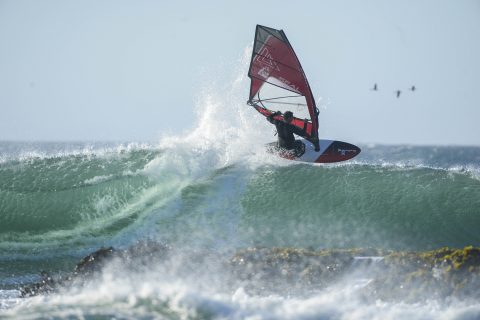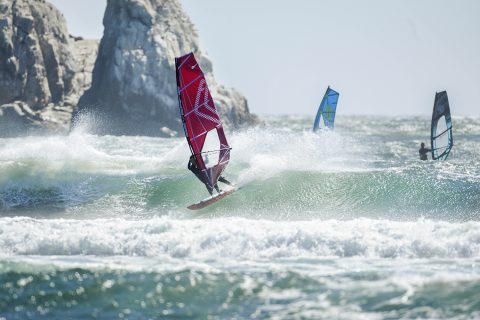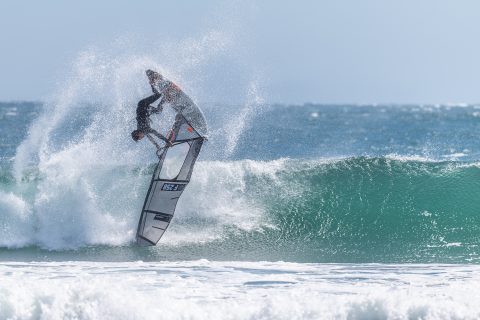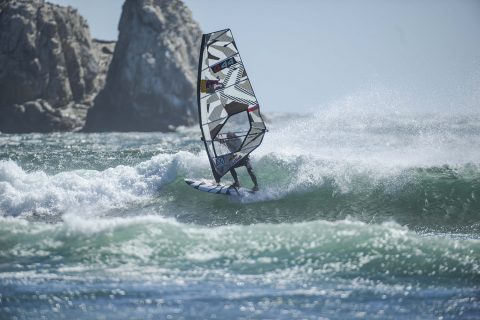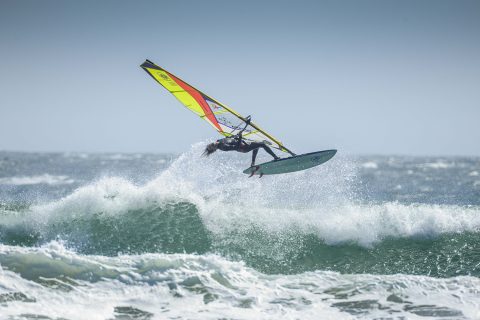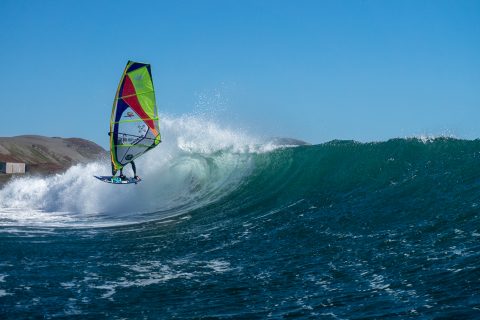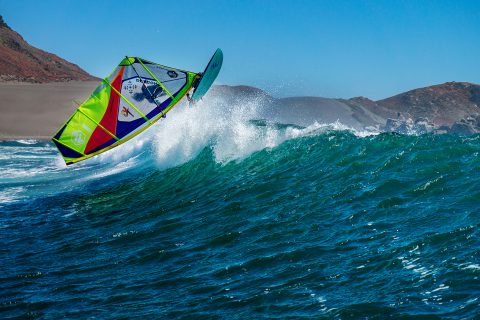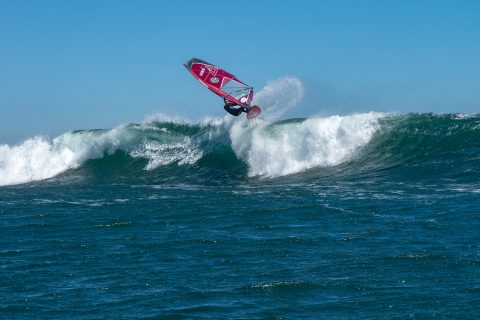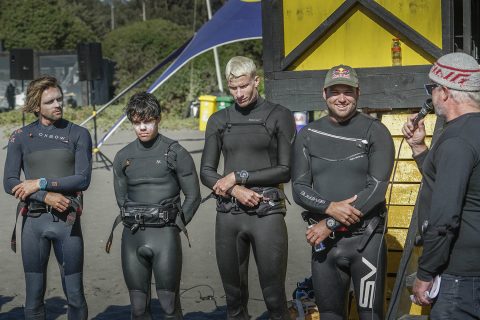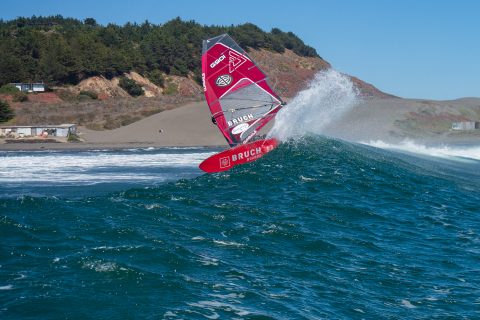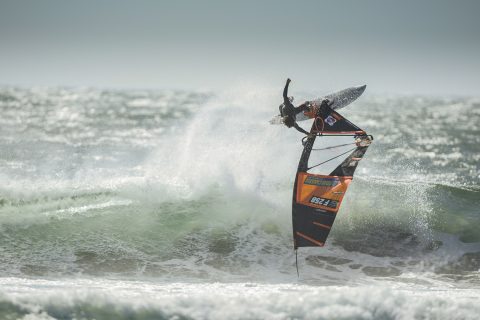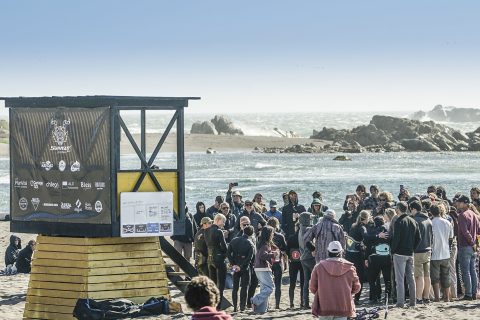CHILE: SURAZO INFERNAL 2023
The IWT / PWA 2023 Surazo Infernal in Chile delivered solid port tack down-the-line riding; a selection of riders give us their thoughts on the event.
Words – Leon Jamaer, Jane Seman, Camille Juban and Simeon Glasson
Photos – Martin Garcia de la Huerta, Agustin Sierra Martinez, Gustavo Harfagar, A Escobar.
Stars And Points – by Leon Jamaer (5th Pro Men)
The Surazo Infernal Chile event started at the end of March just after the World Tour season opener in Japan as the second top event of the now united IWT and PWA Unified Wave Tour. While Japan was considered a 5 star event and the points counted 100 per cent for the world ranking, the positions from the 4 star event in Chile only counted for 40 per cent, meaning a win here would roughly only get you as many points as a 12th place in a 5 star event. The 4 star events, which have less prize money and media coverage, are deliberately not intended to have any significant influence on the world championship title race in order to spare the travel budgets of the top riders. Besides Japan, it’s Fiji, Pozo, Tenerife, Sylt and Maui as full counting events on the 2023 calendar. The two 4 star events in Chile and Peru are intended to give riders in the midfield a chance to prove their skills and to enable up-and-coming riders to qualify with good results for the top level competitions, but whoever expected a weak field of riders in Chile due to the low prize money and the few points to be awarded was wrong! The prospect of participating in an international wave competition in the premium conditions that Chile is known for, not only motivated multiple world champion Philip Köster to sign up, but also attracted a strong international contingent to the Pacific coast. And in addition to the pro divisions, there would also be amateurs, youth and masters divisions – a full program!
- Leon Jamaer
Stoke vs professionalism
The registered talent pool and a good wind and wave forecast made hearts beat faster – finally a World Tour competition with port tack down-the-line conditions! The last time this happened was 2007 in Brazil and professional windsurfing has sorely missed it. The IWT is stepping up to fill that very gap in competitive wave riding. According to tour director Simeon Glasson, the approach is closer to professional surfing and the focus of events run by the IWT is more on riding waves and less on jumps. “It’s about channelling the joy and stoke we all feel when windsurfing in waves into one event and bringing people together in one place with that,” says Simeon, who wears other hats here as Head Judge and Media Coordinator and, to top it all off, competes in the masters division on the water. But is it also about professionally conducting an international competition and determining the best wave windsurfers in the world?
My travelmates and I are bit irritated when the event is renamed at short notice from Topocalma Infernal to Surazo Infernal. Instead of being held at the dream spot of Topocalma, the competition is now to be held directly in front of the Surazo Hotel in Matanzas. The arguments for Matanzas are its good sandbanks and the inconsistent wind in Topocalma. With a good forecast more and more riders sign up at short notice and it’s difficult to understand the seeding and subsequent heat draw logic. Suddenly Jorge García, Philip Köster’s caddy and notorious for his perfect Goiter, is the fourth man in the heat together with Laurin Schmuth and I, which doesn’t make life any easier for us in a pretty stacked side of the draw.
- Matanzas action
Matanzas
The storm that Boris Hermann and Team Malizia faced as they raced around Cape Horn during the Ocean Race to their eventual leg win, pushed big waves along the Chilean coast. But the wind does not play ball despite a great forecast. We have to be patient for a few days and when the hope for the dreamed-of down-the-line conditions is almost fading, the flag for the first pro heats finally goes up! The wind freshens at noon and clean two-metre high waves roll into the rock framed bay of Matanzas. The waves get steep upwind right in front of the rocks and several turns can already be made on the set waves here. However, due to the wind shadow of a big dune, the wind here is very unstable. Every bottom and top turn is high risk. In the lee of the last rock, another steep section builds up, which is ideal for airs and radical manoeuvres. From here on the wave runs relatively fast along the sandbank and usually ends in a closeout. If you pick the right wave and read it well, you can string up to six or seven turns, airs or manoeuvres in a row.
In the first heat, local Alex Vargas shows how it’s done: deep bottom turns, hard carves and solid airs all the way to the beach! The conditions in Matanzas turn on more and more and the competition gets rolling. It’s 18-minute heats with two minutes transition time, so three heats per hour and the start will be on the hour – simple. Theoretically a normal watch is enough to find out your competition time. The best two riders of a heat will advance. Since no jumps count, three judges can evaluate all four riders at the same time. Therefore, no man-against-man or woman-against-woman heats are necessary, as is usually the case in the PWA when jumps count too.
- Leon action
Tactical
The conditions, which live up to the name of the event, last for two days, so that heat after heat, the pro divisions of the women and men can be finished. In the women’s division there are three finals in total, all of which are won by the experienced Jane Seman from Australia with her powerful fast wave rides.
In round 3 I survive a tough heat and can then fight my way into the semi-finals against Camille Juban and Federico Morisio. My tactic is to wait for set waves and ride them from start to finish, like Alex Vargas did on his first wave. Many locals and competitor Julian Salmonn do it similarly. Julian always impresses with fluid wave riding and a good mix of powerful turns, late airs and radical manoeuvres. Riders like Camille, Baptiste Cloarec and Philip Köster, on the other hand, do a lot of aerial tricks, like Goiters and Air Takas, and tend to use smaller but steeper waves. It’s two fundamentally different approaches to riding a wave, but it becomes clear early on, that the judges prefer the aerial tricks in critical parts of the wave. This means for me that I lose out to Baptiste and Camille in a close decision in the semi-final. From the other side of the draw, the Germans Philip and Julian move on to the final along with the two Frenchmen, Baptiste and Camille.
Style
In the 30-minute final, the riders stay true to their respective styles. Camille reels off his entire repertoire of wave riding finesse. Philip succeeds in radical moves like wave 360s, tweaked airs and takas – but sometimes it’s just one good move on a wave. Baptiste goes for radical Goiters, but doesn’t land them as cleanly as he usually does. Personally, the aesthetic well-timed wave rides with a lot of flow from Julian impress me the most. In the end, the judges see Philip in first place, Camille in second, followed by Julian and Baptiste – and thus remain true to their weighting of tricks over complete rides.
Without denying Philip’s great performance, as he once again showed that he is the rider to beat in all kinds of conditions, I think they could have taken the chance here in Chile and honoured the surfing judging criteria of “speed, power and flow” more. There’s always debates around judging, and in the end, it’s also always something that remains subjective.
As the waves are weakening in the following days, the amateur, masters and youth divisions move to the more exposed Topocalma. Here Franky St. Martin from Argentina wins the amateur division, Felipe Wedeles the masters and Liam Dunkerbeck the youths ahead of Hayata Ishii and Inaki Maturana from Chile. Congratulations to all the riders!
- Jaemer action
Conclusion
The IWT and Simeon Glasson, together with the organizers on site and the Surazo Hotel did a masterful job of running a wonderful competition, and thus made an important contribution to professional windsurfing in the waves. While the riders and the organizers are still taking stock of the successful event, the rest of the windsurfing world is waiting for press releases, photos and videos. Although the upload of the pictures fails again and again because of the sporadic internet connection, Simeon is relaxed. The media budget for the event was low, and there was no thoughts of live streaming. First and foremost, according to Simeon, it’s about putting on a good show. The positive emotions of the participants and spectators would find their own way to reach and inspire people. The financial resources available in the sport are simply too small for large media contingents and real-time coverage – and that was something we had to be aware of. Considering that even at the PWA World Cup on Sylt there was no official live stream, one can only agree with him.
In Matanzas however, the enthusiasm about the event was great. The riders soaked up the beautiful vibe of this small village on the Chilean coast and got some nice freesailing sessions in before and after the contest, even though most go home with few points and even less prize money. With my 5th place I am not even within the prize money breakdown of 5000 US dollars in total, divided equally between men and women. In the end, most see it as a mostly self-paid trip with good wind, waves and friends. We all know that if we want to increase the prize money for events like Chile, that the Unified Wave Tour needs to prosper towards a shining series that attracts windsurf fans on all continents, as well as media and potential sponsors. With the next event being Fiji at the beginning of June, hopes are stirred!
This Rugged Land – by
- Jane Seman
(1st Pro Women)
Chile has this raw, rugged feel that makes everywhere you go feel like a bit of an adventure. Most roads around the coast are sketchy dirt tracks that wind through farms and down mountains. As you start your descent down many of the steep U turn bends, you question whether Chile is the place you’ll die, but the moment you see the long peeling left-handers, the excitement takes over, suddenly it’s a risk you’re happy to take.
Learning on the fly
Having done the Japan event, I only arrived one day before the Chile competition started. So I pretty much had to learn to sail Matanzas in my heats. The guys who knew it best were bypassing some closeout sections, finding bits of peeling wave and generally getting three good moves across quite a wide area. But with minimal practice, and seeing how fast it jacks up, I was worried that if I flew too far down the line and past the closeouts, I might completely miss the section for a good move. Instead, I sought out waves that let me do a solid rail carve on the outside and then gun towards a closeout section for a more critical lip hit or aerial. It worked, and I won all three of the finals, but some more time to understand the wave would definitely have been better!
Board choice
Well, I own two boards, so my choices are pretty easy. My everyday Australia/Fiji/Ho’okipa down-the-line board was perfect for Chile. It’s a Severne, 70-litre custom designed by Scotty McKercher with a narrow tail, thin back rails and a quad fin set-up of 110/130.
Once you’re on a wave in Chile, it would be so good to use a really small board, but there are a lot of holes in the wind. Frustratingly, these are often right near the take-off zone. So you still need something with a little bit of float to get the waves in the first place, and then go as small as you can to fit in the sucky, steep sections of the wave.
- Prize giving
Wind, windy, no wind
With so many cliffs and rocks along the coastline, the wind can be very localised and tricky to understand. It can vary by 5-10 knots within even a few hundred metres. So make friends with the locals because it’s really hard to know if it’ll be windy at another spot.
For sails, you really need to take everything to Chile. Well, unless you’re Camille Juban, who only took one sail because he said he does better in competitions when he doesn’t have many back-up options. Stops him going too crazy and crashing too much he reckons. As a side note, he also gave the funniest single word speech I’ve ever heard, “Senoras” he cheekily proclaimed after being presented with the second place trophy.
But back to sail suggestions. In just one day at Topocalma, I went from completely chugging on a 75-litre board with a 4.7m sail, to being overpowered on a 3.7 / 70-litre combo and everything between because the wind was as fickle as a teenager’s fashion choices. Beware of the exfoliating black sand and rig well back on the beach near the vegetation. The walk is way better than the pain of watching a nice clear sail window deteriorate before your very eyes.
- Goiter
Water temperature
Chile is very aptly named, but it’s actually quite comfortable with the right gear. I used a 4×4 Shark Eyes wetsuit and that was perfect. It’s a hybrid surf/dive wetsuit with a built-in hood that came in handy. But the water temperature varied considerably in the two weeks I was there. It’s certainly no day spa, but at the start, I was almost a bit too warm. Then somehow overnight, it felt like it dropped by two degrees – the hood came on and it was borderline booties.
A taste of luxury
I was lucky to score one of the best rooms at Hotel Surazo in Matanzas. There are cheaper places to stay, but if you can, it’s so worth staying there. I could literally lie in my bed and watch the competition, rig on my balcony and walk the 50 metres to the beach. Then walk past a few rooms to enjoy seriously good food and a cold beer with sand between my toes at the beach bar. It’s such a good formula, but surprising how few places worldwide actually get it this right and keep it so accessible for everyone.
Girls can’t windsurf
A more controversial point was just how many local women (and a few men) warned me how ‘macho’ Chile was. I’m being politically correct with that description, but the sad fact is that out of at least 4 locally hired videographers/drone guys, not one filmed even one second of any of the women’s competition. Yet when I sailed in the male dominated Masters division at Topocalma, wearing my gender hiding hoodie and knocking out enough men to get into 5th, I managed to get my only video footage from the event. Footage that was made possible for every other division – youth, master, amateur and pro men – but wasn’t made possible for the women’s division.
Whilst this incident was more of a local issue, there are countless similar stories from the top girls. Our sport needs to stop pretending it’s still the nineties heydays when the rest of the world has moved on. It’s almost funny that windsurfing yearns for more growth and attention, yet there’s still people who think you can achieve that by ignoring or disrespecting 50% of the world’s population.
But that filming inequity was the only negative in a really friendly, adventurous and fun trip. I personally experienced nothing but positive comments and support from the local wave sailing guys. I fought the same way I do at home for waves in the lineup. It’s a cold, rugged place with good waves and you either go hard or someone else will take that opportunity.
- Philip Koester action
A month is good
Overall, Chile feels best for a longer holiday mixed with both surfing and wave sailing. There are some seriously good surfing waves and I barely scratched the surface of what’s possible here. For wave sailing, unless there’s decent swell, the waves at both Matanzas and Topocalma can be really fast and close out across a lot of sections. So it feels like a great place to learn or practice more progressive moves like Goiters and aerial variations between the less frequent days of dreamy perfection. But there’s a huge coastline and there’s plenty more spots to discover. I’d book for a month if I could…and I’d probably end up extending!
So Good – by Camille Juban (2nd Pro Men)
Chile was so good, what the whole coast and the people have to offer is amazing, and that’s before you even start talking about how good the food is! The food at the Surazo hotel was a highlight of my trip because the chef and his team were experts at how to use and mix pretty much only local food in a 5 star way, but the cost wasn’t expensive! The local fish with smash potatoes and veggies was my favourite.
- Camille Juban
I normally just use S2Maui Catalyst (3-batten) and Dragon (4-batten) sails in 4.2 and 4.6. For the contest I used the 4.6 Dragon because it was light, and my faithful 70-litre board with 14 cm centre fin and 10 cm on the sides. This set-up allowed me to be as playful as I wanted on the waves and naturally got me through some heats. My tactic was trying to have a variety of turns in my rides, along with an air game. Looking back it’s funny to think that I only brought one sail size, a 4.6. I didn’t really know what conditions to expect when packing, so I was lucky that we didn’t have to go to Topocalma with 3.7 conditions, ha ha, now I know though!
- Camille in the pit
I’d been to Tirúa in the south of Chile around 6/7 years ago for an invitational event and had just one little session in Matanzas on the way back. But I like the rawness, the wildness and the waves, of this stretch of coast where we were, so I will definitely go back!
I liked seeing the differences in wave sailing styles at the contest. For example Baptiste, the Ishii brothers and Philip Köster are super fast and aerialists, and guys like Leon, Julian and the Chilean locals are pushing the surfing lines style with good carves. Both styles are inspiring for me!
- Camille goiter
Unfortunately 10 days ago at Ho’okipa I broke the cuneiform bone in my left foot and twisted my knee on a small wipeout where my foot stayed stuck in the strap – the classic ha ha! So I’m going back home soon to take care of this to recover as soon as I can, but I’m not sure I will be able to do Fiji. If not, I’ll be ready for the Aloha Classic and next season.
Analysis – by Simeon Glasson (IWT director)
- Philip Koester
It was really interesting to see the different riders tactics for scoring points. I think the thing I noticed most was that riders who couldn’t / didn’t choose great set waves had a hard time scoring high points when they limited themselves to only a classic top to bottom, rail to rail carving style. Great and powerful waves offer high scoring potential for rail-to-rail work, equal to 360 and tweaked air moves if someone is really ripping hard. But… if you’re not getting on great waves in your heat, for whatever reason, then the radical 360s and tweaked aerials definitely offer a little higher scoring potential on those less than perfect waves. It’s wise to have and use all the tools in the toolbox to get the most out of any given conditions.
- action from the water
Results
Pro Men
1 Philip Köster
2 Camille Juban
3 Julian Salmonn
4 Baptiste Cloarec
- Philip Koester
Women
1 Jane Seman
2 Björte Pürschel
3 Carolyne Vita
4 Giannina Sarno
- Prize time
Youth
1 Liam Dunkerbeck
2 Hayata Ishii
3 Inaki Maturana
4 Jose Martin
- Julian ripping
Masters
1 Felipe Wedeles
2 Arnaud Frennet
3 Killian du Couedic
4 Mariano Pecora
- Marino Gil
Open Amateurs
1 Franky St Martin
2 Michael Friedl
3 Tato Octavio Caravalo
4 Juan Ignacio Marisio
- Goiter time
Grand Masters
1 Michael Friedl
2 Nicolas Recordan
3 Olly Barta
- Matanzas

